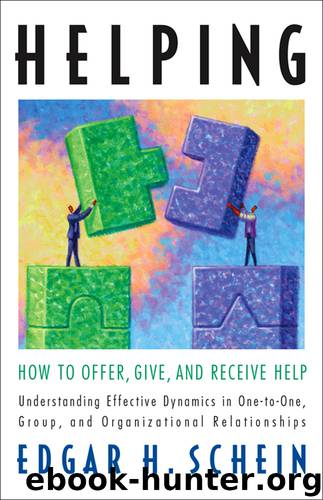Helping by Edgar Schein

Author:Edgar Schein
Language: eng
Format: epub
Publisher: Berrett-Koehler Publishers
Published: 2009-01-16T16:00:00+00:00
Constructive Opportunism
Pure inquiry biases the interaction toward going with the flow, and that must be balanced by constructive opportunism. The major criterion for when to seize an opportunity to shift focus is when the client has said something that has obvious significance to the story and that is vivid enough to be remembered. In other words, a shift in focus or role should be clearly linked to something the client said, not merely to the helper’s thoughts or feelings. Especially in deciding when to switch from pure inquiry into the diagnostic or confrontational mode, timing is therefore crucial. Sometimes such a shift is appropriate within the first few minutes; other times one should stay in pure inquiry throughout the interaction. Helpers often jump back and forth among the three modes based on what they hear and how they react to it, but there are no simple criteria for deciding when the timing is right for a shift in focus. If the client does not provide clear information that permits shifting away from pure inquiry, then it is perhaps best to stay in the process consultant role.
On the other hand, one cannot just become a passive inquiry machine. While listening, the helper may have strong feelings and ideas, and they may be highly relevant to helping the client understand the situation. When the timing feels right, the helper can take some risks and seize an opportunity to provide a new insight, a new alternative, a new way of looking at things. In the next chapter, the case of Jim illustrates that seizing such opportunities sometimes results in an error, either in terms of timing or the level of the intervention. The client may then reject the helper, which leads to a period of tension in the relationship. At such times the helper must recognize that the client’s reaction reveals not only that the helper may have erred, but also demonstrates how the client reacts to certain kinds of input. In other words, everything that happens is a source of data to be learned from.
We make conversational errors all the time in what we say, how we say it, or in the timing of when we say it. Instead of being discouraged by such errors, we should recognize that they provide opportunities for learning and should therefore be welcomed. We may learn a lesson, such as “Be more careful in how you state things,” or “Don’t make assumptions—access your ignorance,” but we must always go beyond the lesson and ask what this new information reveals about the situation. The learning thus occurs in two domains in that the reaction to the error gives us data about ourselves and what we might have done differently, as well as data about clients — how they think about things and what they are ready for.
Download
This site does not store any files on its server. We only index and link to content provided by other sites. Please contact the content providers to delete copyright contents if any and email us, we'll remove relevant links or contents immediately.
Bad Blood by John Carreyrou(6271)
Rich Dad Poor Dad by Robert T. Kiyosaki(6173)
Principles: Life and Work by Ray Dalio(5953)
Playing to Win_ How Strategy Really Works by A.G. Lafley & Roger L. Martin(5485)
Management Strategies for the Cloud Revolution: How Cloud Computing Is Transforming Business and Why You Can't Afford to Be Left Behind by Charles Babcock(4438)
The Confidence Code by Katty Kay(4033)
Thinking in Bets by Annie Duke(3995)
American Kingpin by Nick Bilton(3502)
Delivering Happiness by Tony Hsieh(3280)
Project Animal Farm: An Accidental Journey into the Secret World of Farming and the Truth About Our Food by Sonia Faruqi(3011)
The Power of Habit by Charles Duhigg(2961)
Mastering Bitcoin: Programming the Open Blockchain by Andreas M. Antonopoulos(2889)
Brotopia by Emily Chang(2889)
The Tyranny of Metrics by Jerry Z. Muller(2845)
I Live in the Future & Here's How It Works by Nick Bilton(2840)
The Marketing Plan Handbook: Develop Big-Picture Marketing Plans for Pennies on the Dollar by Robert W. Bly(2792)
The Content Trap by Bharat Anand(2775)
Building a StoryBrand by Donald Miller(2751)
Applied Empathy by Michael Ventura(2742)
